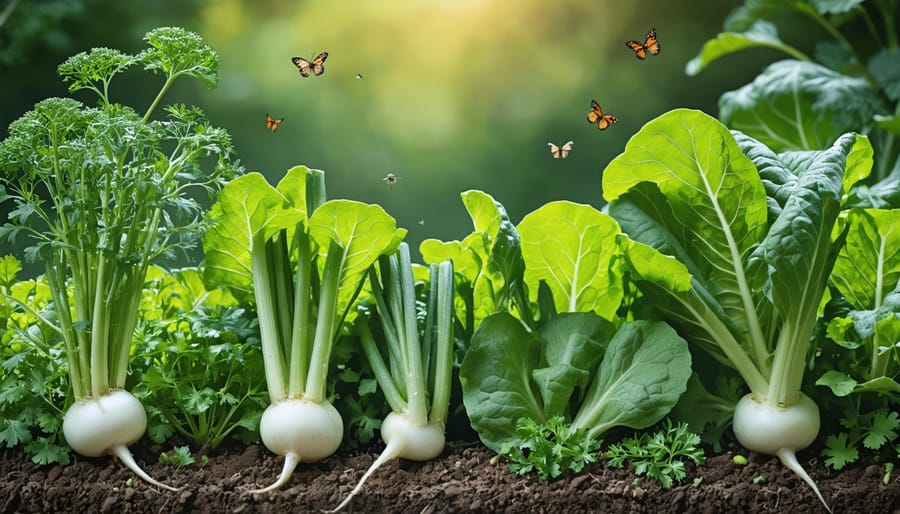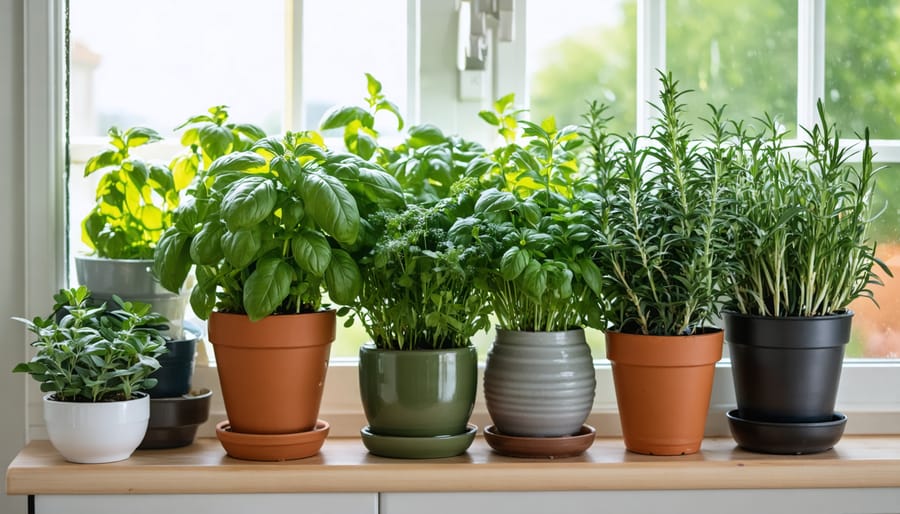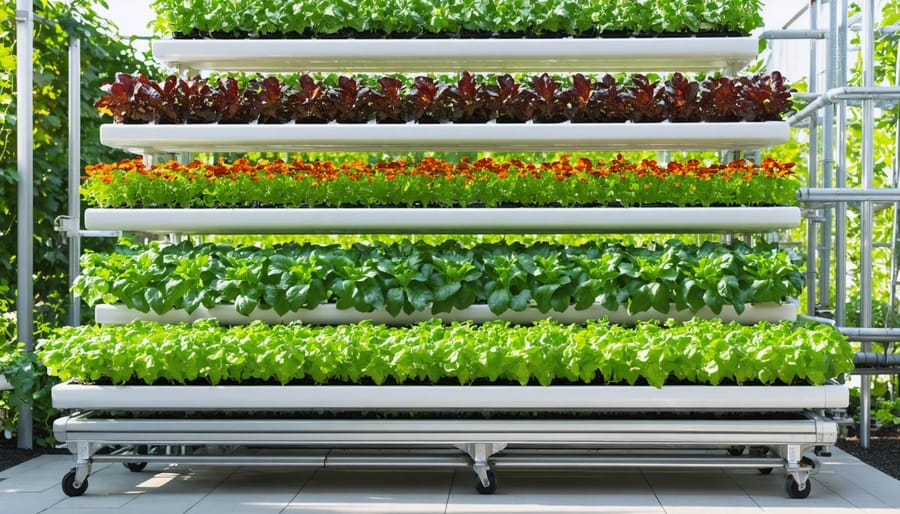Transform your kohlrabi patch into a thriving ecosystem by mastering essential companion planting principles. Plant aromatic herbs like dill and cilantro alongside kohlrabi to naturally deter cabbage moths and other brassica pests while attracting beneficial pollinators. Interplant shallow-rooted lettuce and spinach between kohlrabi rows to maximize garden space and create beneficial ground cover that retains soil moisture. Keep kohlrabi separate from deep-rooted vegetables like tomatoes and pole beans, which compete for nutrients and can stunt bulb development. This strategic planting approach not only enhances kohlrabi growth but also creates a balanced garden ecosystem where each plant contributes to the overall health and productivity of your growing space.
Best Companion Plants for Kohlrabi
Herbs That Love Kohlrabi
Aromatic herbs make excellent companions for kohlrabi, creating a fragrant and beneficial environment in your garden. If you’re already growing herbs, you’ll be delighted to know that many of them can help protect and enhance your kohlrabi patch.
Dill is particularly beneficial, as it attracts beneficial insects that help control pests while its deep roots help break up the soil. Thyme creates a lovely ground cover that retains moisture and suppresses weeds around your kohlrabi plants. The strong scent of sage helps deter cabbage moths and other unwanted insects, while oregano’s natural compounds can improve the flavor of nearby vegetables.
Plant aromatic herbs in a circle around your kohlrabi or intersperse them throughout the bed. Chamomile is especially helpful, as it releases compounds that strengthen neighboring plants and improves their essential oil content. Mint can also be beneficial but should be planted in containers to prevent spreading. Remember to trim herbs regularly to prevent them from overshadowing your kohlrabi plants while maintaining their protective benefits.
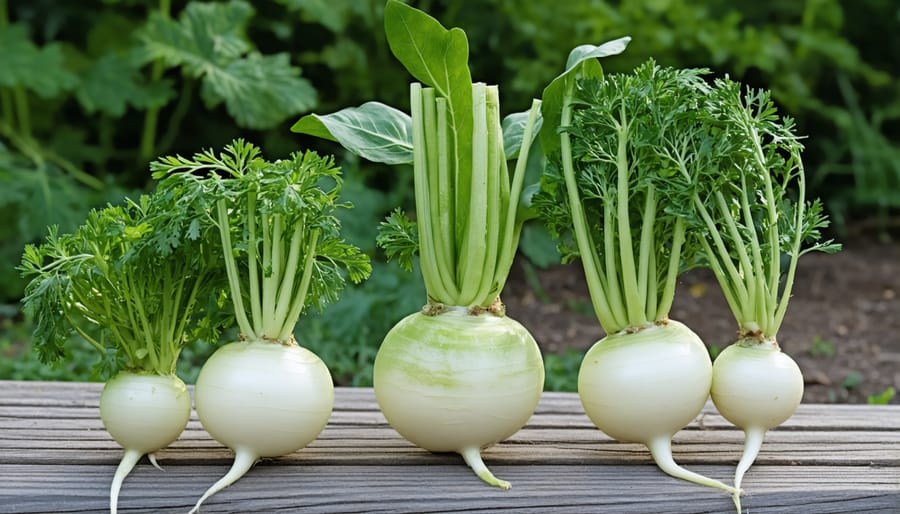
Vegetable Companions
Kohlrabi plays well with many vegetable companions in the garden, making it an excellent choice for maximizing your growing space. Root vegetables like carrots and beets make particularly good neighbors, as they utilize different soil depths and don’t compete for nutrients. Onions and garlic are excellent companions that help deter pests while adding diversity to your garden bed.
For successful companion planting, try growing kohlrabi alongside bush beans, which help fix nitrogen in the soil, benefiting your kohlrabi’s growth. Lettuce and other shallow-rooted greens work wonderfully as ground cover beneath kohlrabi plants, helping retain soil moisture and suppress weeds.
Consider planting aromatic herbs like dill, sage, and mint nearby to confuse and repel common cabbage pests. These herbs not only protect your kohlrabi but also attract beneficial insects that help with pollination and pest control throughout your garden.
Remember to space your companions appropriately, giving each plant enough room to thrive without overcrowding. A good rule of thumb is to maintain about 8-12 inches between kohlrabi and its vegetable neighbors.
Beneficial Flower Partners
Brighten up your kohlrabi patch with flowering companions that not only add beauty but also serve as natural pest deterrents and pollinator magnets. Marigolds are excellent partners, as their strong scent helps repel cabbage moths and other unwanted insects. Plant these cheerful flowers along the borders of your kohlrabi bed for maximum protection. Sweet alyssum creates a lovely ground cover that attracts beneficial insects while helping retain soil moisture. Nasturtiums are another fantastic choice, pulling double duty by attracting pollinators and acting as a trap crop for aphids. Consider adding calendula, whose bright orange blooms not only attract beneficial insects but also have natural antifungal properties that can help protect your kohlrabi. For maximum benefit, scatter these flowering companions throughout your kohlrabi bed rather than limiting them to one area.
Plants to Avoid Near Kohlrabi
While kohlrabi is generally a friendly garden companion, there are several plants that don’t play well with this versatile vegetable. Understanding these incompatible pairings will help you create a more harmonious and productive garden space.
Pole beans and climbing vines should be kept away from kohlrabi, as they can overshadow the plants and compete for nutrients. Their sprawling growth habits can also interfere with kohlrabi’s development, potentially leading to stunted growth or misshapen bulbs.
Strawberries and kohlrabi make particularly poor neighbors. Both plants are heavy feeders and will compete intensely for the same nutrients in the soil. Additionally, strawberries can attract pests that may harm your kohlrabi crop.
Other brassica family members, such as cabbage, broccoli, and cauliflower, should be planted in different areas of your garden. While they’re relatives, grouping them together can increase the risk of disease spread and attract larger populations of cabbage-family pests like cabbage worms and root maggots.
Tomatoes and peppers are also best kept separate from kohlrabi. These nightshade family members have different soil and nutrient requirements, and their growth patterns can interfere with kohlrabi’s development. They may also release compounds that can inhibit kohlrabi’s growth.
Fennel is another plant to avoid placing near kohlrabi. Known for its allelopathic properties, fennel releases chemicals that can suppress the growth of nearby plants, including kohlrabi. This natural chemical warfare can result in poor development and reduced yields.
By keeping these plants separate from your kohlrabi patch, you’ll create better growing conditions for all your vegetables and maximize your garden’s potential.
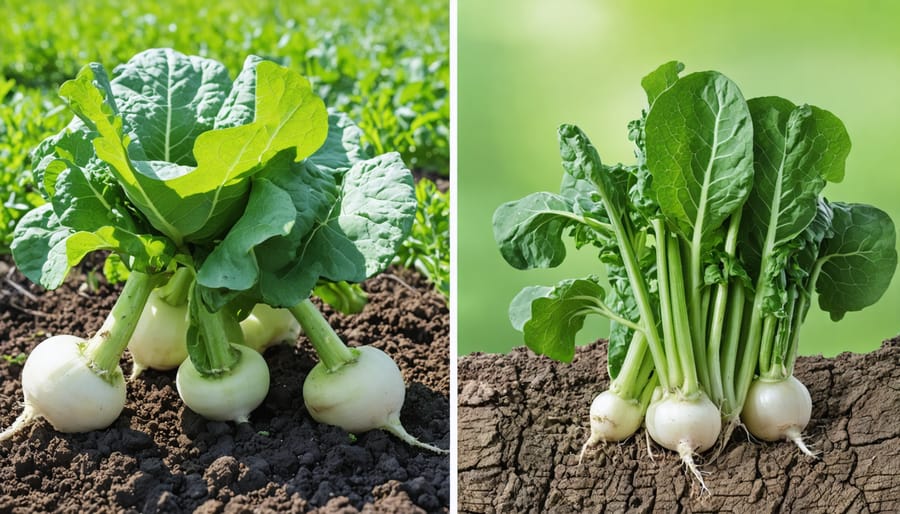
Planting Layout Strategies
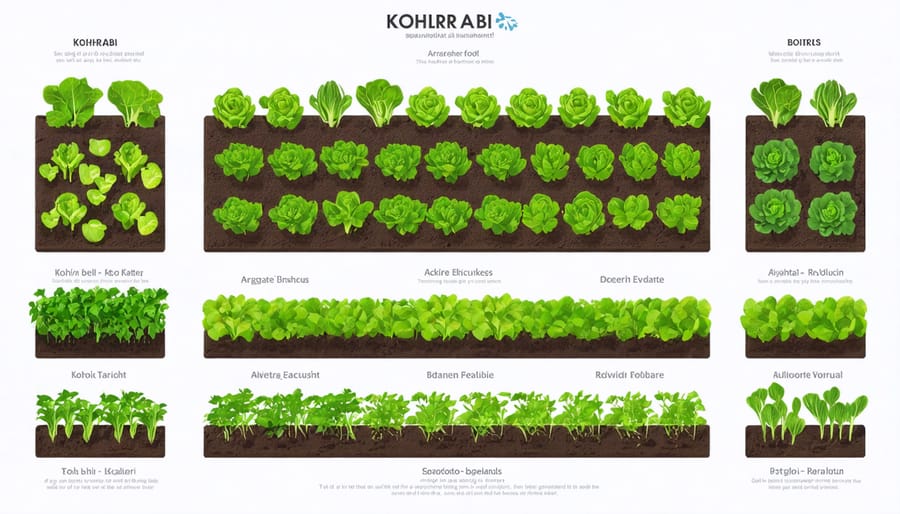
Spacing Guidelines
When planning your kohlrabi companion garden, proper spacing is crucial for successful growth and harmonious plant relationships. In raised bed gardens or traditional plots, give each kohlrabi plant 8-12 inches of space between neighbors, with rows spaced 18-24 inches apart.
For companion plants, maintain these recommended distances while considering their mature sizes. Plant smaller companions like herbs 6-8 inches from kohlrabi, while larger plants like bush beans should be kept 12-15 inches away. When interplanting with quick-growing crops like lettuce or radishes, you can place them between kohlrabi plants, utilizing the space while the kohlrabi is still young.
Create alternating rows of kohlrabi and companions, or try a triangular pattern for more efficient space usage. Remember that proper spacing not only prevents competition for nutrients and water but also promotes good air circulation, reducing the risk of disease. For square foot gardening enthusiasts, limit yourself to one kohlrabi plant per square foot to ensure optimal growth conditions.
Seasonal Considerations
Kohlrabi is a cool-season crop that thrives when planted in early spring or late summer for a fall harvest. For spring planting, sow your kohlrabi and companion plants as soon as the soil can be worked, typically 4-6 weeks before the last frost date. This timing allows companion plants like lettuce, spinach, and other leafy greens to establish themselves alongside kohlrabi in the cooler weather they all prefer.
For fall harvests, plant your kohlrabi companions in late summer, about 6-8 weeks before the first expected frost. This autumn planting can be particularly successful with herbs like dill and cilantro, which bolt less readily in cooling temperatures. Remember that some companions, such as bush beans, need to be planted earlier in the season to ensure they complete their growing cycle before frost arrives.
Consider succession planting with fast-growing companions like radishes every two weeks throughout the growing season. This strategy ensures a continuous harvest while maximizing the benefits of companion planting. In warmer climates, provide afternoon shade for kohlrabi and its companions during the height of summer to prevent bolting and maintain optimal growing conditions.
Maintenance Tips for Companion Planted Beds
Maintaining a companion-planted bed with kohlrabi requires attention to detail and regular care, but the rewards are well worth the effort. Start by establishing a consistent watering schedule that considers the needs of all your companion plants. While kohlrabi prefers even moisture, be careful not to overwater, as this can lead to root rot and affect neighboring plants.
Mulching is particularly important in companion planted beds. Apply a 2-3 inch layer of organic mulch around your plants, being careful not to pile it against the stems. This helps retain moisture, suppress weeds, and maintain soil temperature, benefiting all your garden companions.
Regular weeding is crucial, as weeds can compete with both kohlrabi and its companions for nutrients and water. Hand pull weeds carefully to avoid disturbing the root systems of your planted vegetables. Pay special attention to the areas between different plant groupings where weeds often try to establish themselves.
Monitor plant spacing as your garden grows. While companion planting often involves close spacing, overcrowding can lead to competition and reduced yields. Don’t hesitate to thin out plants if they become too dense, ensuring each plant has adequate space to thrive.
Feed your garden bed with balanced organic fertilizer every 4-6 weeks during the growing season. Consider using compost tea or fish emulsion, which benefit both kohlrabi and its companions without overwhelming any particular plant.
Keep an eye out for pest problems affecting any of your companion plants, as issues can quickly spread throughout the bed. Implement integrated pest management strategies, such as handpicking insects or using organic pest deterrents that won’t harm beneficial insects.
Regularly inspect your plants for signs of disease or nutrient deficiencies. The beauty of companion planting is that many plant combinations naturally help prevent these issues, but early detection and treatment are still important for maintaining a healthy garden.
Finally, maintain good air circulation by pruning dense foliage when necessary and removing any deceased plant material promptly to prevent disease spread among your companion plants.
Companion planting with kohlrabi offers an exciting way to maximize your garden’s potential while naturally protecting and nurturing your crops. By pairing kohlrabi with compatible plants like herbs, leafy greens, and root vegetables, you’ll create a thriving garden ecosystem that benefits all your plants. Remember to keep kohlrabi away from incompatible plants like pole beans and tomatoes, and maintain proper spacing to ensure each plant has room to grow. Whether you’re a novice gardener or a seasoned pro, experimenting with companion planting can lead to healthier plants, better harvests, and a more sustainable garden. Start small with a few proven combinations, observe what works best in your space, and enjoy the rewarding experience of watching your garden flourish through thoughtful plant partnerships.

